Folded 1985 Conference Western Founded 1983 | League USFL Division Pacific Division Based in Los Angeles | |
 | ||
Team History Los Angeles Express (1983–1985) Team colors Express blue, silver, burgundy, white Home field | ||
The Los Angeles Express was a team in the United States Football League (USFL) based in Los Angeles, California. Playing at the Los Angeles Memorial Coliseum, the Express competed in all three of the USFL seasons played, 1983–1985.
Contents
- Pre history
- 1983 season
- 1984 season
- Offseason disaster
- 1985 season
- Aftermath
- Single season leaders
- Trivia
- References

Pre-history
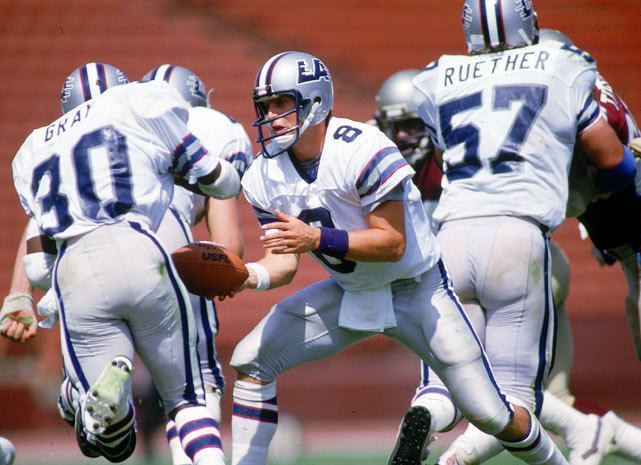
Cable television pioneers Alan Harmon and Bill Daniels were awarded a USFL franchise for San Diego when the league announced its formation in 1982. However, the city refused to grant the team a lease to play at Jack Murphy Stadium under pressure from the stadium's existing tenants—baseball's Padres, the NFL's Chargers, and the NASL's Sockers. The only other outdoor facility available in the area was Balboa Stadium, the original home of the Chargers. However, it was a relatively antiquated facility (built in 1915) that had not had a major tenant since the Chargers moved into Jack Murphy in 1967, and was now largely used by high school teams. This was an untenable situation for a team that was aspiring to be part of a major sports league.
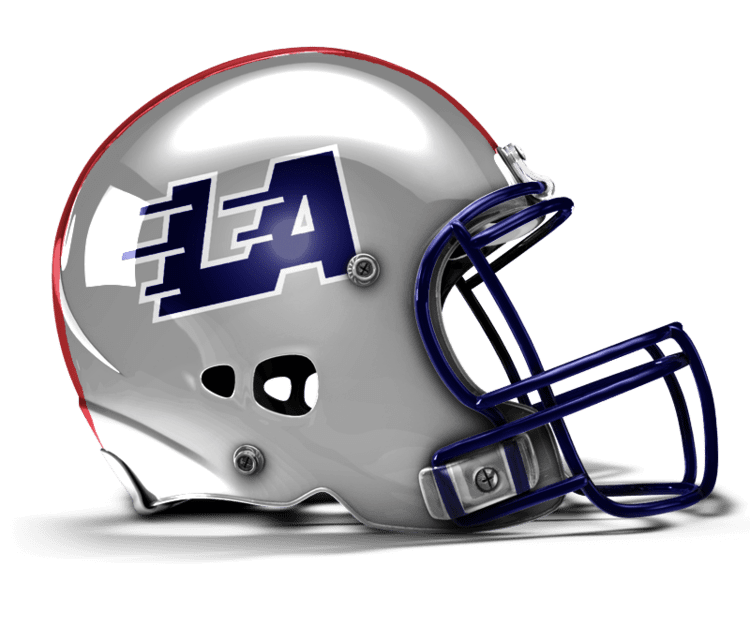
With only eight months before the season was to start, Harmon and Daniels decided to move to Los Angeles with the league's blessing—in the process, forcing Jim Joseph, second owner of the Los Angeles USFL franchise, to move his team. Joseph relocated his franchise to Phoenix, Arizona, as the Arizona Wranglers.
1983 season
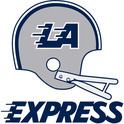
The Los Angeles Express drafted Dan Marino as the first pick in USFL history. Marino made some appearances on behalf of the Express before signing with the Miami Dolphins.
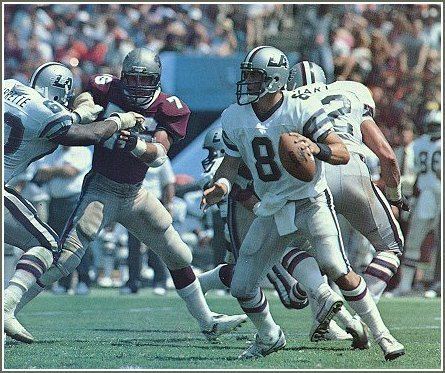
The Express also made a serious run at Eric Dickerson, and actually matched the Los Angeles Rams' offer for him. However, Dickerson signed with the Rams, apparently because family members were skeptical about the USFL.
Television star Lee Majors became part owner in April 1983.
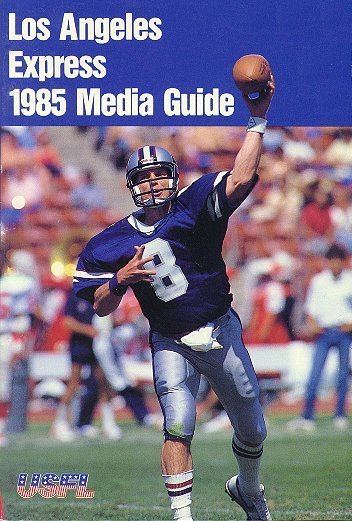
The Express ownership lured Canadian Football League legend Hugh Campbell, head coach of the Edmonton Eskimos, to be their first head coach. (Campbell had taken over the Eskimos in 1977 and in his six years had taken the team to six straight Grey Cup games, winning the last five.)

The 1983 Express team was a competitive team headed by quarterbacks Tom Ramsey and Mike Rae and led by an above average defense. Despite losing two defensive backs to knee injuries, the Express finished fifth in the league in total defense.
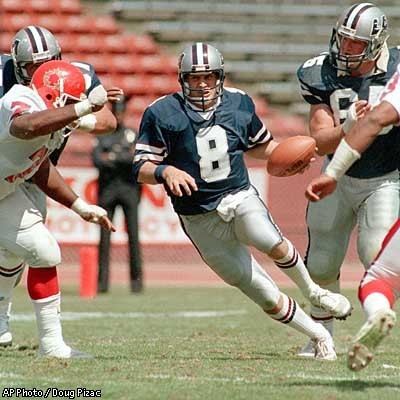
However, a patchwork offensive line limited the team's offensive firepower. The Express had the worst rushing attack in the league. (Herschel Walker rushed for 72 more yards than the entire Express team in 1983).
Upset losses to the New Jersey Generals and Washington Federals in weeks 16 and 17 respectively cost the Express the Pacific Division title and allowed the Oakland Invaders to claim the last 1983 playoff berth.
1984 season
Billionaire investor and vacuum cleaner salesman J. William Oldenburg bought the team and hired veteran executive Don Klosterman as general manager. Former Chargers quarterback John Hadl was hired as coach. Klosterman spent an enormous amount of money assembled an impressive stable of young talent, capped off by the signing of Steve Young, a quarterback who had played at the namesake university of his lineal ancestor, Brigham Young University. Agent Leigh Steinberg negotiated for Young what was then reported to be the largest professional sports contract ever signed – a 10-year deal worth over US$40 million. The payments were to be in the form of an annuity set up to pay him $1 million annually for the next 42 years, so the value of the contract was considerably less than stated.
The team struggled to compete with the popularity of the Rams and the Los Angeles Raiders, who had just won the Super Bowl. Despite the all-star lineup, Southern Californians viewed the Express largely with indifference. They only drew 15,000 people per game–4,000 fewer than they drew a year earlier. On three occasions, the team drew crowds of fewer than 11,000 people. The crowds looked even smaller than that due to the cavernous size of the Coliseum, which seated almost 95,000 people at the time and was far too big for an NFL team (the Raiders had trouble filling it even in their Super Bowl year), let alone a USFL team. It was so spread out that even crowds of 25,000—a decent-sized crowd by USFL standards—looked sparse.
In spite of its overwhelming talent and one of the league's highest payrolls, the young team struggled with adjusting to the pro game and injuries, only finishing two games over .500 at 10-8. However, this tied the Wranglers for first place in the Pacific Division. The Express won the division title on a tiebreaker, and got to play the Michigan Panthers, who had limped into the playoffs with a 4-8 record in their last 12 games since losing star wide receiver Anthony Carter for the season, while Arizona got Jim Kelly's red hot 13-5 Houston Gamblers. The playoff game against the Panthers drew only 7,900 fans. As it turned out, that game was the longest in professional football history—a three-overtime, 93 minute and 33 second marathon won by the Express 27-21.
The Wranglers had managed to upset the Gamblers 17-16 on a late rally. The Express would have hosted the conference championship game, but were forced to play in Arizona because the Coliseum was being readied for the 1984 Summer Olympics. They lost to the Wranglers, 35-23.
Offseason disaster
The bubble burst for the Express in 1985. Largely due to poor attendance, the Express reportedly lost $15 million in 1984 despite the team advancing all the way to the conference title game. The league got a rude shock midway through the season when several of Oldenburg's financial dealings in other areas caught up with him. He had tried to sell the team after the 1984 season, but was delayed when a savings and loan sued him for breach of contract. He was eventually cleared to sell the team, but by that time he could not find a buyer. Oldenburg turned the team over to the league.
The league could not fold the team because of a clause in its television contract with ABC requiring the league to have teams in the nation's three largest markets. While ABC had not concerned itself with the demise of the Chicago Blitz after the 1984 season, the league's owners feared that ABC would pull its contract if the Express were shut down—an action that would have probably killed the league. Potential buyers were scared off by the prospect of having to assume the burden of huge player contracts.
1985 season
As bad as the situation with the Blitz had been for the league in 1984, the Express were even worse in 1985. Not only did the Express' roster costs dwarf Chicago's due to the large contracts, but the league had contracted in the off-season and there were only 13 other teams to contribute to supporting the Express.
After two close losses to start the season, the injury bug bit the team hard, decimating the roster. At that point, the season turned into a complete fiasco. The Express would lose seven more games before they notched a win. The nine-game losing streak was the second-longest in league history, behind only the Wranglers' 10-game losing streak in 1983. One of those games was a 51-0 thrashing by the Denver Gold—the largest margin of defeat in league history. The Express' on-field collapse was all the more stunning since this was essentially the same team that nearly advanced to the conference championship game a year earlier. However, the young Express players suspected that the team wouldn't be around for the planned move to the fall in 1986, even if the league managed to survive the 1985 season. With this in mind, they played tentatively, fearing injuries that might diminish their future NFL prospects.
The other owners had decided to run the Express on a shoestring budget until another owner could be found, and were resistant to allow more money for signing replacements. Despite a myriad of cost-cutting moves (such as firing the cheerleaders), the Express nearly missed one game when the bus driver's check bounced and he refused to drive them to the Coliseum. Young and other players chipped in enough money to make up the difference, and the driver took them to the game. Young had to play this game at running back because the Express did not have any healthy running backs.
Attendance continued to plummet; they only drew 8,500 fans per game. League commissioner Harry Usher was under fire to find an owner and fix the Express' problem. Desperate for a solution, Usher had the team try a smaller stadium for its final home game— John Shephard Stadium on the campus of Los Angeles Pierce College, a junior college in the San Fernando Valley. The stadium's capacity was expanded to 16,000 for the game. Usher and the league owners hoped if the game did well they might have some ammunition to land a potential owner. However, the game was still not a sellout; only 8,200 people—barely half of the stadium's capacity—actually attended to see Young and the Express lose 21-10 to Doug Williams and the Arizona Outlaws. While this was double what the Express had drawn for their previous two home games at the Coliseum, the experiment was so embarrassing that Usher nearly lost his job. The team's final record was 3-15, last in the league.
Unable to find a new owner for the Express, the league announced the team would suspend operations for the 1986 season. However, many of the very issues that plagued the Express in 1985 made it very likely the team would not have returned even if the league had succeeded in winning a large payoff from the NFL to finance a move to the fall. Additionally, the Express would have had to compete against two NFL teams and, if they had returned to the Coliseum, would have had to share their home with one of them and the University of Southern California's team.
Aftermath
After trying all season, Steve Young and Gary Zimmerman were finally able to buy their way out of the USFL. Both went on to Hall of Fame careers in the NFL.
The Los Angeles Express name was briefly revived in 2013 for a proposed A-11 Football League team, but those plans fell through in April 2014 due to California's workers compensation situation.
